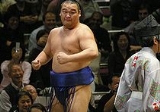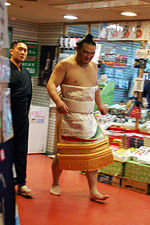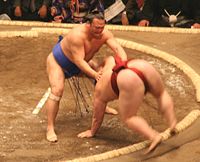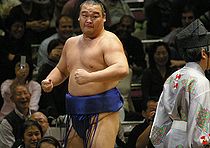
Takamisakari Seiken
Encyclopedia
Takamisakari Seiken is a sumo
wrestler from Aomori Prefecture
, Japan
. A former amateur champion, he turned professional in 1999 and established himself in the top division in 2002 after a brief appearance in 2000. He has received five special prizes
for his achievements in tournaments and earned two gold stars
for defeating yokozuna. The highest rank he has reached is komusubi, which he has held on two occasions. He is one of the most popular wrestlers in sumo today, largely due to his eccentric warm-ups before his matches.
, Kitatsugaru District
, Katō was an amateur sumo champion at Nihon University
, winning the College Yokozuna title in his final year. He began his professional sumo career as a makushita tsukedashi (a promising amateur allowed to start at a level significantly higher than entry level) in March 1999, wrestling under his own name. He reached jūryō, the second-highest division, in January 2000, at which point he changed his fighting name
to Takamisakari.
 Three tournaments later, in July of the same year, he was promoted to the top makuuchi
Three tournaments later, in July of the same year, he was promoted to the top makuuchi
division, becoming only the second wrestler (and first Japanese born) from his Azumazeki stable
to achieve this feat. In September he acted as tsuyuharai
("dew-sweeper", an honorary attendant) in stablemate Yokozuna Akebono
's ring-entering ceremony, but he was injured on the third day of that tournament. Enforced absence from the next two tournaments saw him demoted all the way back to the unsalaried makushita division, where he had begun his career. It took him until March 2002 to work his way back up to the makuuchi division, and in September he reached komusubi, his highest rank to date. He only held this rank for one tournament, however, dropping back to maegashira in November. He has earned five special prizes
, and has two gold stars
for defeating yokozuna, both earned in the July 2003 tournament where he was also awarded the Outstanding Performance prize. Although he again reached komusubi in November 2003, he again failed to retain the rank and has been a middle-level maegashira since then.
Takamisakari again appeared in a yokozunas ring-entered ceremony in September 2005, when he replaced Asasekiryū
, who was injured, as sword-bearer
. On the first day he accidentally scraped the sword against the ceiling.
He came close to demotion from the top division after missing five bouts through injury in November 2007. However in the next tournament he achieved a majority of wins against losses from the maegashira 14 ranking. In May 2011 he could score only 7-8 at maegashira 15 but actually rose one place in the rankings for the following tournament due to the large number of wrestlers retiring over a match-fixing scandal. However his run of 56 consecutive makuuchi tournaments ended when he could only score 3-12 in the July 2011 basho.
Takamisakari is a hugely popular wrestler. He builds himself up for each bout with a somewhat eccentric series of muscle flexes and slaps, and throws a copious amount of salt onto the dohyō
. In a culture where impassivity
is sometimes seen as a sign of strength, he makes no attempt to hide his emotions, obviously elated after each win and inconsolably dejected after each loss (though even then often he will receive generous applause from the audience). Even though he usually performs in the middle to lower ranks, the winner of his matches are always greatly rewarded with kensho (prize money) provided by his sponsor, a food company.

. He favours yotsu techniques
, preferring a right-hand inside, left-hand outside grip on his opponent's mawashi
(migi-yotsu), and 26 of his 41 wins between July 2007 and May 2008 were by yori-kiri, or a simple force out. He is also known for his effort and technique at the edge of the ring, which often allow him to win matches in which just a moment earlier it appeared that he would be pushed out.

Sumo
is a competitive full-contact sport where a wrestler attempts to force another wrestler out of a circular ring or to touch the ground with anything other than the soles of the feet. The sport originated in Japan, the only country where it is practiced professionally...
wrestler from Aomori Prefecture
Aomori Prefecture
is a prefecture of Japan located in the Tōhoku Region. The capital is the city of Aomori.- History :Until the Meiji Restoration, the area of Aomori prefecture was known as Mutsu Province....
, Japan
Japan
Japan is an island nation in East Asia. Located in the Pacific Ocean, it lies to the east of the Sea of Japan, China, North Korea, South Korea and Russia, stretching from the Sea of Okhotsk in the north to the East China Sea and Taiwan in the south...
. A former amateur champion, he turned professional in 1999 and established himself in the top division in 2002 after a brief appearance in 2000. He has received five special prizes
Sansho (Sumo)
Sanshō are the three special prizes awarded to top division sumo wrestlers for exceptional performance during a sumo honbasho or tournament. The prizes were first awarded in November 1947.-Criteria:...
for his achievements in tournaments and earned two gold stars
Kinboshi
Kinboshi is a notation used in professional sumo wrestling to record a lower-ranked wrestler's victory over a yokozuna....
for defeating yokozuna. The highest rank he has reached is komusubi, which he has held on two occasions. He is one of the most popular wrestlers in sumo today, largely due to his eccentric warm-ups before his matches.
Career
Born in ItayanagiItayanagi, Aomori
is a town located in the Kitatsugaru District of northeastern Aomori Prefecture in the Tōhoku region of Japan. As of 2009, the town had an estimated population of 15,404 and a density of 368 persons per km². Its total area was 41.81 km².-Geography:...
, Kitatsugaru District
Kitatsugaru District, Aomori
is a district located in Aomori Prefecture, Japan.As of 2003, the district has an estimated population of 59,751 and a density of 110.21 persons per km²...
, Katō was an amateur sumo champion at Nihon University
Nihon University
Nihon University is the largest university in Japan. Akiyoshi Yamada, the minister of justice, founded Nihon Law School in October 1889....
, winning the College Yokozuna title in his final year. He began his professional sumo career as a makushita tsukedashi (a promising amateur allowed to start at a level significantly higher than entry level) in March 1999, wrestling under his own name. He reached jūryō, the second-highest division, in January 2000, at which point he changed his fighting name
Shikona
A shikona is a sumo wrestler's ring name.As with standard Japanese names, a shikona consists of a 'surname' and a 'given' name, and the full name is written surname first. However, the given name is rarely used outside formal or ceremonial occasions. Thus, the former yokozuna Asashōryū Akinori is...
to Takamisakari.

Makuuchi
or is the top division of professional sumo. Its size is fixed at 42 wrestlers , ordered into five ranks according to their ability as defined by their performance in previous tournaments....
division, becoming only the second wrestler (and first Japanese born) from his Azumazeki stable
Azumazeki Stable
is a stable of sumo wrestlers, one of the Takasago group of stables. It is located at Higashi–Komagata, Sumida, Tokyo. It was founded in April 1986 by the Hawaiian born Takamiyama of the Takasago stable. Azumazeki's first sekitori was Akebono, also from Hawaii, in 1990, who subsequently reached the...
to achieve this feat. In September he acted as tsuyuharai
Tsuyuharai
In professional sumo, the tsuyuharai is one of the two attendants that accompany a yokozuna when he performs his dohyo-iri or ring entrance ceremony. The other attendant is called the tachimochi....
("dew-sweeper", an honorary attendant) in stablemate Yokozuna Akebono
Akebono Taro
is a retired American born-Japanese sumo wrestler from Waimānalo, Hawaii. Joining the professional sport in Japan in 1988, he was trained by pioneering Hawaiian sumo wrestler Takamiyama and rose swiftly up the rankings, reaching the top division in 1990...
's ring-entering ceremony, but he was injured on the third day of that tournament. Enforced absence from the next two tournaments saw him demoted all the way back to the unsalaried makushita division, where he had begun his career. It took him until March 2002 to work his way back up to the makuuchi division, and in September he reached komusubi, his highest rank to date. He only held this rank for one tournament, however, dropping back to maegashira in November. He has earned five special prizes
Sansho (Sumo)
Sanshō are the three special prizes awarded to top division sumo wrestlers for exceptional performance during a sumo honbasho or tournament. The prizes were first awarded in November 1947.-Criteria:...
, and has two gold stars
Kinboshi
Kinboshi is a notation used in professional sumo wrestling to record a lower-ranked wrestler's victory over a yokozuna....
for defeating yokozuna, both earned in the July 2003 tournament where he was also awarded the Outstanding Performance prize. Although he again reached komusubi in November 2003, he again failed to retain the rank and has been a middle-level maegashira since then.
Takamisakari again appeared in a yokozunas ring-entered ceremony in September 2005, when he replaced Asasekiryū
Asasekiryu Taro
Asasekiryū Tarō is a sumo wrestler. He made his debut in January 2000, reaching the top division in March 2003. He has won four special prizes, and has spent a total of five tournaments to date in the titled sanyaku ranks...
, who was injured, as sword-bearer
Tachimochi
In professional sumo, the tachimochi is one of the two attendants that accompany a yokozuna when he performs his dohyo-iri or ring entrance ceremony. The other attendant is called the tsuyuharai....
. On the first day he accidentally scraped the sword against the ceiling.
He came close to demotion from the top division after missing five bouts through injury in November 2007. However in the next tournament he achieved a majority of wins against losses from the maegashira 14 ranking. In May 2011 he could score only 7-8 at maegashira 15 but actually rose one place in the rankings for the following tournament due to the large number of wrestlers retiring over a match-fixing scandal. However his run of 56 consecutive makuuchi tournaments ended when he could only score 3-12 in the July 2011 basho.
Takamisakari is a hugely popular wrestler. He builds himself up for each bout with a somewhat eccentric series of muscle flexes and slaps, and throws a copious amount of salt onto the dohyō
Dohyo
thumb|A dohyōThe dohyō is the ring in which sumo wrestling bouts are held. A modern dohyo is a circle of rice-straw bales 4.55 meters in diameter, mounted on a square platform of clay 6.7m on a side, and 34 to 60 cm high. The surface is covered by sand.A new dohyō is built prior to each...
. In a culture where impassivity
Affect display
In psychology, affect display or affective display is a subject's externally displayed affect. The display can be by facial, vocal, or gestural means . When displayed affect is different from the subjective affect, it is incongruent affect...
is sometimes seen as a sign of strength, he makes no attempt to hide his emotions, obviously elated after each win and inconsolably dejected after each loss (though even then often he will receive generous applause from the audience). Even though he usually performs in the middle to lower ranks, the winner of his matches are always greatly rewarded with kensho (prize money) provided by his sponsor, a food company.

Fighting style
Takamisakari has a straightforward fighting style, rarely resorting to sidestepping at the initial chargeTachi-ai
The tachi-ai is the initial charge between two sumo wrestlers at the beginning of a bout.There are several common techniques that wrestlers use at the tachi-ai, with the aim of getting a decisive advantage in the bout:...
. He favours yotsu techniques
Kimarite
Kimarite are winning techniques in a sumo bout. For each bout in a Grand Sumo tournament , a sumo referee, or gyoji, will decide and announce the type of kimarite used by the winner...
, preferring a right-hand inside, left-hand outside grip on his opponent's mawashi
Mawashi
In sumo, a mawashi is the belt that the rikishi wears during training or in competition. Upper ranked professional wrestlers wear a keshō-mawashi as part of the ring entry ceremony or dohyo-iri.-Mawashi:...
(migi-yotsu), and 26 of his 41 wins between July 2007 and May 2008 were by yori-kiri, or a simple force out. He is also known for his effort and technique at the edge of the ring, which often allow him to win matches in which just a moment earlier it appeared that he would be pushed out.
In popular culture

- He is known in Japan as "RoboCopRoboCopRoboCop is a 1987 American science fiction-action film directed by Paul Verhoeven. Set in a crime-ridden Detroit, Michigan in the near future, RoboCop centers on a police officer who is brutally murdered and subsequently re-created as a super-human cyborg known as "RoboCop"...
". The nickname was given to him by former Yokozuna AkebonoAkebono Tarois a retired American born-Japanese sumo wrestler from Waimānalo, Hawaii. Joining the professional sport in Japan in 1988, he was trained by pioneering Hawaiian sumo wrestler Takamiyama and rose swiftly up the rankings, reaching the top division in 1990...
, who was his senpaiSenpaiand are an essential element of Japanese seniority-based status relationships, similar to the way that family and other relationships are decided based on age, with even twins being divided into elder and younger sibling...
, in reference to his robot-like movements at the dohyōDohyothumb|A dohyōThe dohyō is the ring in which sumo wrestling bouts are held. A modern dohyo is a circle of rice-straw bales 4.55 meters in diameter, mounted on a square platform of clay 6.7m on a side, and 34 to 60 cm high. The surface is covered by sand.A new dohyō is built prior to each...
.
- He is a fan of the anime series Gundam Seed.
- He is also nearsighted, which explains why he squints a lot on the dohyōDohyothumb|A dohyōThe dohyō is the ring in which sumo wrestling bouts are held. A modern dohyo is a circle of rice-straw bales 4.55 meters in diameter, mounted on a square platform of clay 6.7m on a side, and 34 to 60 cm high. The surface is covered by sand.A new dohyō is built prior to each...
. He wears glasses when outside of the ring.
Makuuchi and Jūryō record
See also
- Glossary of sumo termsGlossary of sumo termsThe following words are terms used in sumo wrestling in Japan. azukari : Hold. A kind of draw. After a mono-ii, the gyōji or the shimpan "holds" the result if it was too close to call...
- List of sumo tournament second division winners
- List of active sumo wrestlers
External links
- Japanese Sumo Association Biography (English)(Japanese)
- complete biography and basho results (Japanese)

